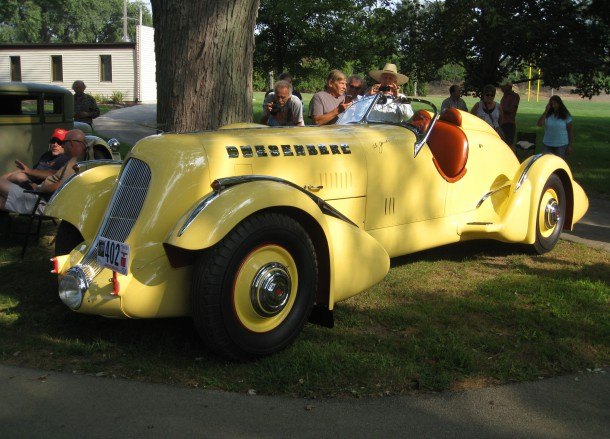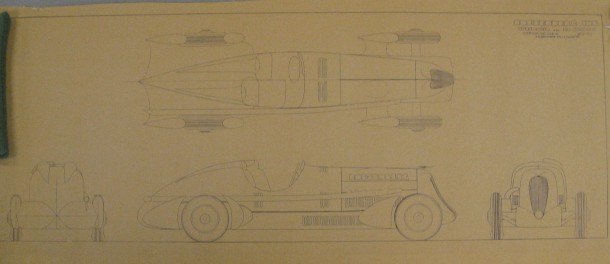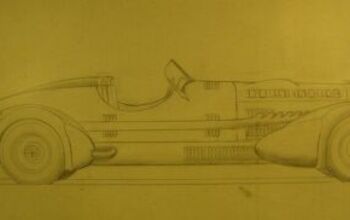Ab Jenkins and His Mormon Meteor, Part Two (With Designer's Original Drawings)

In Part One, we saw how Ab Jenkins started his speed record career in a Studebaker, then moving to Pierce-Arrow. His greatest success, though, would be at the wheel of a Duesenberg.
Because its name is German, a lot of people are mistaken in thinking that Duesenbergs — as other magnificent classic-era cars like Hispano-Suizas — came from the European continent. Fred and Augie Duesenberg though, were from the heartland of America, based in Indiana, with a factory in Indianapolis. While the name Duesenberg is most often associated with the great Model J, before E.L. Cord bought their company and tasked the brothers with building the best automobile in the world, Duesenberg made its name in racing. In fact, nearly half of all competitors in the 1931 Indy 500 qualified with either a Duesenberg chassis or engine — or both.
Ab Jenkins and the Mormon Meteor
Despite their prevalence in the field that year, the Duesenbergs’ best racing years were behind them. A Duesenberg finished second in 1931, behind one of Harry Miller’s designs. By the early 1930s, Miller’s cars were dominating track racing all over America. Also, the Duesenberg brothers’ attention was refocused on producing the Model J. Fred Duesenberg retired from racing following the 1931 Indianapolis race.
The centrifugally supercharged Model SJ was introduced in 1932, but unfortunately Fred Duesenberg didn’t live to see it achieve the status it did in the hierarchy of great American cars. He died following an automobile accident in the same year.
While the Model J and SJ were and are great cars, the world was in the midst of the Great Depression. Cord had hoped to sell 500 cars a year, though only a few more than 500 were built in total. Perhaps because Augie Duesenberg wasn’t that busy with production, in 1934 he decided to get back into motorsports and built a car first known as the Duesenberg Special specifically for Jenkins’ land speed record attempts. It’s possible that Jenkins’ old friend Roy Faulkner was involved in the decision, as he was then president of Auburn, part of Cord’s consortium of car companies.
J-557’s centrifugal supercharger fed twin two-barrel carburetors with pressurized air.
Today it’s known as the Mormon Meteor, but with the exception of a few mechanical modifications and custom bodywork it was pretty much a standard Model SJ Duesenberg, which makes its success versus purpose-built LSR cars like Hans Stuck’s Auto Union race cars designed by Ferdinand Porsche all the more impressive. Jenkins’ new car was not given a chassis number and was identified by the company as J-557, the number of the straight-eight engine. Besides the supercharger, Augie Duesenberg added two duplex carburetors, custom ram’s horn intake manifolds and a higher 7.5-to-1 compression ratio. It was measured on the dyno at the Duesenberg plant at 390 to 400 horsepower at a then-unheard-of 5,000 rpm. The Special was also given a lower final drive ratio to help with top speed. Since the stock Model J was capable of 84 mph in second gear, the overall gearing must have been very long.
Ab Jenkins and Augie Duesenberg. Note the prominent Plumb Tools [correction: Plomb] logo. Jenkins was a pioneer in getting promotional endorsements and sponsorships.
To get the car closer to the ground, the chassis was given a custom, lowered tubular front axle and 18-inch steel disc wheels versus the production Model J’s 19-inch wire spoke rims.The body was designed by Duesenberg chief designer J. Herbert Newport. Not as well known as other stylists who worked for Cord’s companies like Alan Leamy and Gordon Buehrig, Newport had the responsbility of making the Model J — originally designed in the late 1920s with that era’s formal style — look contemporary in the mid 1930s, when streamlining was the rage.
Wind tunnel testing was not common then so Newport and Augie Duesenberg came up with some commonsense solutions. Using an overall shape that looks a bit like a radical take on the Speedster from one of Cord’s other companies, Auburn, Newport gave it an angled radiator shell and a Cyclops-like single round headlight mounted low like the Pierce 12 Special Jenkins used in his 1933 record attempts. The tapered tail was in line with what early aerodynamicists like Paul Jaray had theorized, and drag was further reduced by a louvered belly pan that ran the length of the car’s underside. The exposed tires were given fairings to smooth the airflow.
With a Duesenberg arrow hood ornament installed, in late August of 1935 — in 120 degree heat — the Mormon Meteor, which was newly renamed following a contest in a Salt Lake City newspaper (it was a different era; had three-time Indy 500 winner Maury Rose gone after the LSR, perhaps his car would have been named the Jewish Javelin) and Jenkins at the wheel, it averaged 145.47 mph over 3,262 miles in 24 hours. He set a one-hour record at over 152 mph, besting the Stuck’s previous record by more than 17 mph.
The Mormon Meteor wasn’t the only record setting car the Jenkins’ drove on the salt flats that summer. He also set 70 AAA records for stock cars in a production Auburn 851 boattail speedster. The Auburn company produced a newsreel documentary about both runs.
Jenkins’ 152 mph record would later fall to aircraft powered vehicles, and Augie Duesenberg responded by getting U.S. government approval to use a military sourced Curtiss Conqueror V-12 engine with 650 horsepower in the car, renamed Mormon Meteor II. That version of the car set records in 1936 and 1937, but by then drivers like Campbell were going after 300 mph and the production Model J chassis was not up to that speed. A purpose-built, aircraft-engine powered Mormon Meteor III would be used in Jenkins’ further LSR attempts.
‘Ram’s horn’ intake manifolds were some of Augie Duesenberg’s performance mods to J-557.
Ab Jenkins though, had a special affection for the original Mormon Meteor. After the car was retired from competition in 1938 he bought it from Duesenberg, had the original J-557 Duesenberg eight reinstalled, and added bumpers and a couple more headlights. Doors were cut into the body and the high mounted side exhaust pipes were lowered to accommodate them. A windshield was added, as were more complete fenders, some chrome trim and running lights. Jenkins used the Meteor as a daily driver while he served as Salt Lake City mayor during World War II. For the duration of the war, his salt flat runs were limited to publicity events in support of things like war bonds and to test tires for Firestone, also used in the war effort. Some of those runs set records and it’s possible that Jenkins still holds more automotive speed records than any other human being.
After the war, Jenkins returned to endurance driving. At the age of 73, in 1956, he and his son Marvin were hired by Pontiac to set 28 endurance records in the Pontiac Series 860 sedan. Even at that age, Ab was at the wheel for two-thirds of the 24-hour run, running on just milk and orange juice.
Jenkins’ set records on the Bonneville Salt Flats in this Pontiac at the age of 73. He died of a heart attack not long afterwards and the car model was renamed Bonneville in his honor.
Shortly thereafter, Jenkins died of a sudden heart attack on a promotional tour for Pontiac. To honor him, the Series 860 was renamed the Bonneville.
In his career as a speed record driver, Jenkins covered about 2 million miles with few mishaps. Besides being billed as the “fastest,” Jenkins was promoted by his sponsors as the “safest” driver in America, completing many long distance record runs on public roads without ever getting a ticket. Even many of his closed course record speed runs were said to be run for safety research as well as stressed testing. One reason for his safety record is that many of those miles were logged with his car being the only one on the course. Ab thought that racing wheel to wheel was more dangerous than shaving at 125 mph.
The Mormon Meteor is a special automobile. To give you an idea of how special it is, these photographs were taken at this year’s Auburn Cord Duesenberg Festival, held in Auburn, Indiana. I was taking pictures of the dozens of Model Js on display, likely the largest collection of Duesenbergs I’d likely see in one place. In addition to the Dueseys, there were also many other great cars like Cord L-29s and the later 810/812 Cord models, plus a bunch of Auburn Speedsters, any one of them able to draw a crowd at any car show.
Then the Mormon Meteor drove onto the show field. With the supercharged straight eight blowing through a tuned tubular manifold and an open exhaust pipe, the roar caught people’s attention. When they realized what it was, every head turned to watch it.
That day was the second time in a week that I’d driven down to Auburn, having misread a date and gotten there a week early for the festival. I knew something was wrong when the town was bereft of prewar cars, save for those in the ACD Museum. When I came down on the correct date, I wasn’t anticipating a third trip. Then someone told me that the Duesenbergs would be out at the Goshen, Indiana airport the following day to drag race on the runway in their annual Thunderrun. Well how many times will you get to see $1 million, irreplaceable Duesenbergs put the pedal to the metal and drag race?
Goshen is about two hours past Yenemsvelt, but I got there just in time to see the Mormon Meteor make its runs and shoot the accompanying video.
If that wasn’t enough of a rare car guy opportunity, while researching this article I popped J. Herbert Newport’s name into a search engine. Serendipitously, one of the first results was a finding aid for the J. Herbert Newport collection at the University of Michigan’s library’s Special Collections department, housed in the U’s grad library, about 45 minutes from my house.
J. Herbert Newport’s pencil on acetate drawing of the Duesenberg Special / Mormon Meteor
Perusing the finding aid, I discovered that the collection has materials related to the Mormon Meteor, including one of Newport’s own pencil on acetate drawings of the car and related blueprints. Those prints are dated 1934, so they were likely used in the fabrication of the Meteor’s body. It’s quite possible that this is the first time they’ve ever been published.
Special thanks to the staff at the University of Michigan Hatcher Graduate Library’s Special Collections department.
A full photo gallery of the Mormon Meteor can be seen here, with 3D video here.
Ronnie Schreiber edits Cars In Depth, a realistic perspective on cars & car culture and the original 3D car site. If you found this post worthwhile, you can get a parallax view at Cars In Depth. If the 3D thing freaks you out, don’t worry, all the photo and video players in use at the site have mono options. Thanks for reading – RJS

Ronnie Schreiber edits Cars In Depth, the original 3D car site.
More by Ronnie Schreiber
Latest Car Reviews
Read moreLatest Product Reviews
Read moreRecent Comments
- Varezhka Maybe the volume was not big enough to really matter anyways, but losing a “passenger car” for a mostly “light truck” line-up should help Subaru with their CAFE numbers too.
- Varezhka For this category my car of choice would be the CX-50. But between the two cars listed I’d select the RAV4 over CR-V. I’ve always preferred NA over small turbos and for hybrids THS’ longer history shows in its refinement.
- AZFelix I would suggest a variation on the 'fcuk, marry, kill' game using 'track, buy, lease' with three similar automotive selections.
- Formula m For the gas versions I like the Honda CRV. Haven’t driven the hybrids yet.
- SCE to AUX All that lift makes for an easy rollover of your $70k truck.





















































Comments
Join the conversation
Beautiful car. Great article. Think, however, that you will find the car is a Marmon, not "Mormon".
Wow, this is a really cool peek into automotive racing history. Great job!